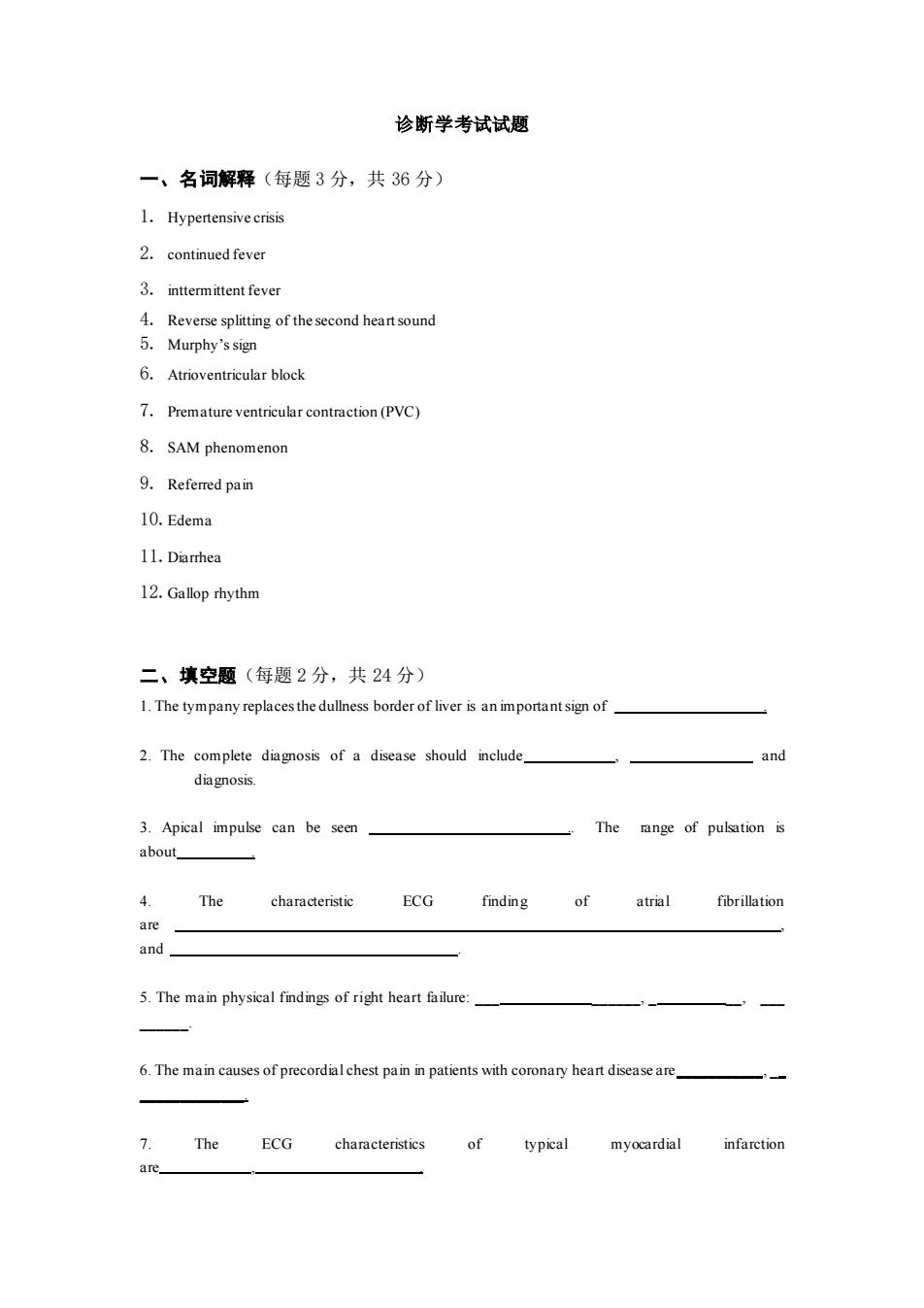
诊断学考试试题 一、名词解释(每题3分,共36分) 1.Hypertensivecrisis 2.continued fever 3.inttermitent fever 4.Reverse splitting of the second heart sound 5.Murphy's sign 6.Atrioventricular block 7.Premature ventricular contraction(PVC) 8.SAM phenomenon 9.Referred pain 10.Edema 11.Diarhea 12.Gallop rhythm 二、填空题(每题2分,共24分) 1.The tympany replacesthe dullness border of liver is an imporantsign of 2.The complete diagnosis of a disease should include an diagnosis. 3.Apical impulse can be secn The range of pulsation is about_ 4.The characteristic ECG finding of atrial fibrillation are and】 5.The main physical findings of right heart failure: 6.The main causes of precordialchest pain in patients with coronary heart diseaseare 7.The ECG characteristics of typical myocardial infarction are
诊断学考试试题 一、名词解释(每题 3 分,共 36 分) 1. Hypertensive crisis 2. continued fever 3. inttermittent fever 4. Reverse splitting of the second heart sound 5. Murphy’s sign 6. Atrioventricular block 7. Premature ventricular contraction (PVC) 8. SAM phenomenon 9. Referred pain 10.Edema 11.Diarrhea 12.Gallop rhythm 二、填空题(每题 2 分,共 24 分) 1. The tympany replaces the dullness border of liver is an important sign of . 2. The complete diagnosis of a disease should include , and diagnosis. 3. Apical impulse can be seen . The range of pulsation is about . 4. The characteristic ECG finding of atrial fibrillation are , and . 5. The main physical findings of right heart failure: _ _, _ _, _ _. 6. The main causes of precordial chest pain in patients with coronary heart disease are_, _ _. 7. The ECG characteristics of typical myocardial infarction are ,
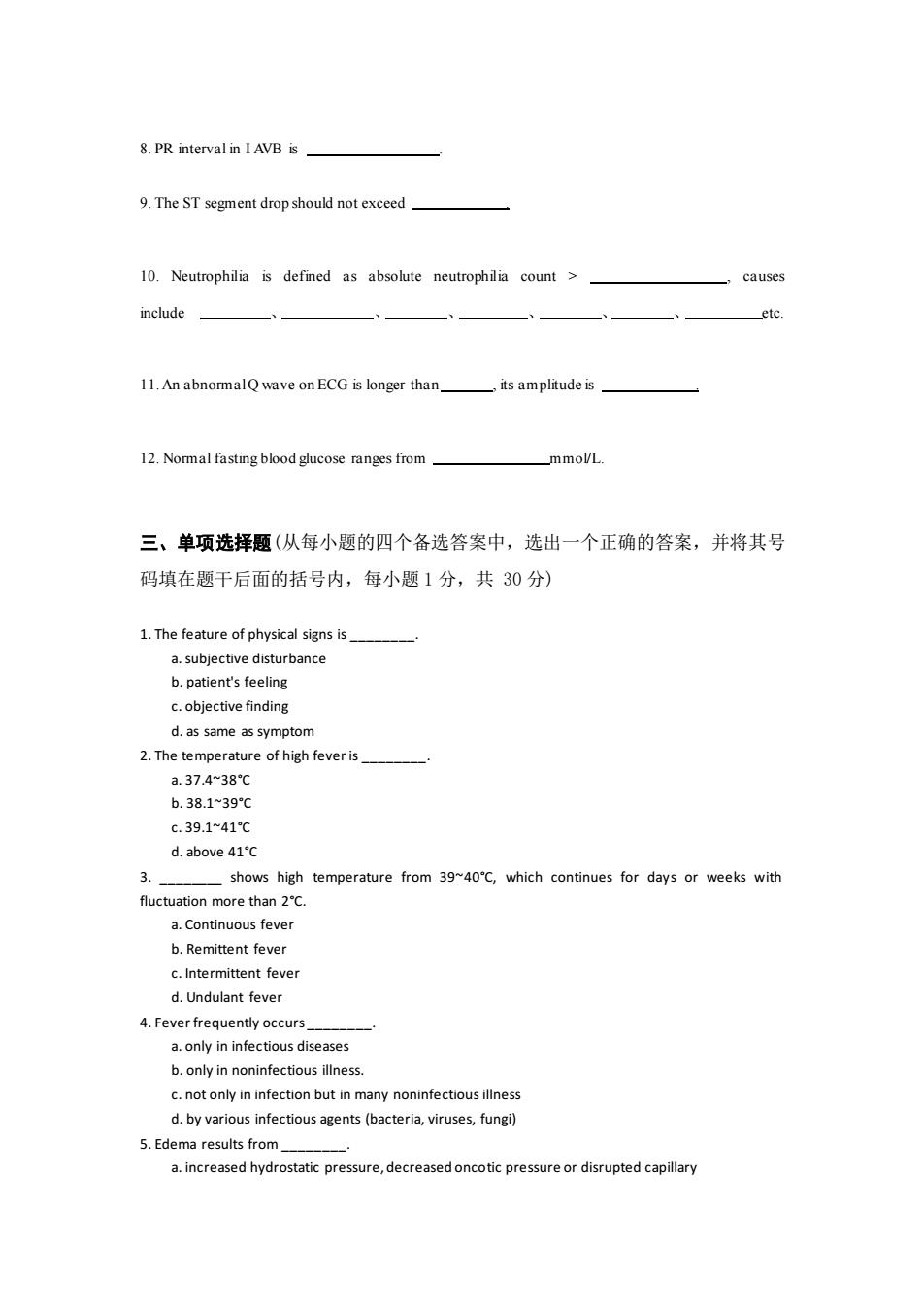
8.PR interval in IAVB is 9.The ST segment drop should not exceed 10.Neutrophilia is defined as absolute neutrophilia count> causes include etc 11.An abnormalQ wave on ECG is longer than. its amplitude is 12.Normal fasting blood glucose ranges from mmol/L 三、单项选择题(从每小题的四个备选答案中,选出一个正确的答案,并将其号 码填在题干后面的括号内,每小题1分,共30分) 1.The feature of physical signs is a.subiective disturbance b.patient's feeling c.objective finding d.as same as symptom 2.The temperature of high fever is a.37.4~38℃ b.38.1~39C c.39.141℃ d.above 41C 3. shows high temperature from 39~40C,which continues for days or weeks with fluctuation more than 2C a.Continuous fever b.Remittent fever c.Intermittent feve d.Undulant feve 4.Fever frequently occurs a.only in infectious diseases c.notonyininfectonbutinmanynoninfectioustlnes d.by various infectious agents(bacteria,viruses,fungi) 5.Edema results from_ a.increased hydrostatic pressure,decreased oncotic pressure or disrupted capillary
8. PR interval in I AVB is . 9. The ST segment drop should not exceed . 10. Neutrophilia is defined as absolute neutrophilia count > , causes include 、 、 、 、 、 、 etc. 11. An abnormal Q wave on ECG is longer than , its amplitude is . 12. Normal fasting blood glucose ranges from mmol/L. 三、单项选择题(从每小题的四个备选答案中,选出一个正确的答案,并将其号 码填在题干后面的括号内,每小题 1 分,共 30 分) 1. The feature of physical signs is _. a. subjective disturbance b. patient's feeling c. objective finding d. as same as symptom 2. The temperature of high fever is _. a. 37.4~38°C b. 38.1~39°C c. 39.1~41°C d. above 41°C 3. _ shows high temperature from 39~40°C, which continues for days or weeks with fluctuation more than 2°C. a. Continuous fever b. Remittent fever c. Intermittent fever d. Undulant fever 4. Fever frequently occurs _. a. only in infectious diseases b. only in noninfectious illness. c. not only in infection but in many noninfectious illness d. by various infectious agents (bacteria, viruses, fungi) 5. Edema results from _. a. increased hydrostatic pressure, decreased oncotic pressure or disrupted capillary
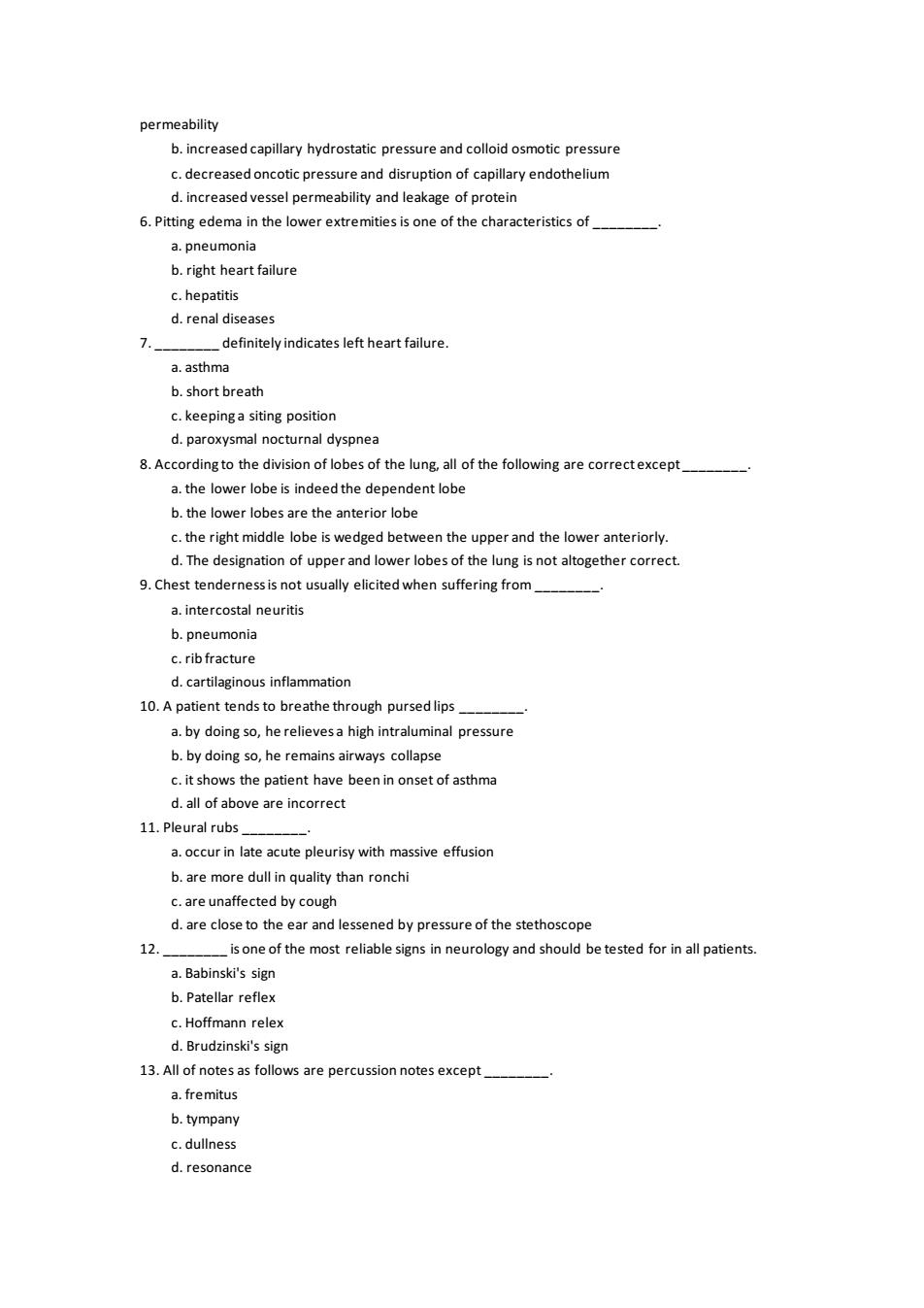
permeability c.decreased oncotic pressure and disruption of capillary endothelium d.increased vessel permeability and leakage of protein 6.Pitting edema in the lower extremities is one of the characteristics of_ a.pneumonia b.right heart failure c.hepatitis d.renal diseases definitely indicates left heart failure a.asthma b.short breath 8.According to the division of lobes of the lung,all of the following are correctexcept a.the lower lobe is indeed the dependent lobe b.the lower lobes are the anterior lobe upperand ignation of uppe fthe lung is not altogether correc 9.Chest tenderness is not usually elicited when suffering from a.intercostal neuritis b.pneumonia c.rib fracture d.cartlagi ous inflammation 10.Apatient tendsto breathe through pursedlips a.by doing so,he relievesa high intraluminal pressure b.by doing so,he remains airways collapse c.it shows the patient have been in onset of asthma d.all of above are 11.Pleuralrubs a.occur in late acute pleurisy with massive effusion b.are more dull in quality than ronchi c.are unaffected by cough d.the earand by pressure of the 12 be tested for in all patients a.Babinski's sign b.Patellar reflex c.Hoffmann relex d.Brudzinski's sign 13.All of notes as foll are pe ssion notes except a.fremitus b.tympany c.dullness d.resonance
permeability b. increased capillary hydrostatic pressure and colloid osmotic pressure c. decreased oncotic pressure and disruption of capillary endothelium d. increased vessel permeability and leakage of protein 6. Pitting edema in the lower extremities is one of the characteristics of _. a. pneumonia b. right heart failure c. hepatitis d. renal diseases 7. _ definitely indicates left heart failure. a. asthma b. short breath c. keeping a siting position d. paroxysmal nocturnal dyspnea 8. According to the division of lobes of the lung, all of the following are correct except _. a. the lower lobe is indeed the dependent lobe b. the lower lobes are the anterior lobe c. the right middle lobe is wedged between the upper and the lower anteriorly. d. The designation of upper and lower lobes of the lung is not altogether correct. 9. Chest tenderness is not usually elicited when suffering from _. a. intercostal neuritis b. pneumonia c. rib fracture d. cartilaginous inflammation 10. A patient tends to breathe through pursed lips _. a. by doing so, he relieves a high intraluminal pressure b. by doing so, he remains airways collapse c. it shows the patient have been in onset of asthma d. all of above are incorrect 11. Pleural rubs _. a. occur in late acute pleurisy with massive effusion b. are more dull in quality than ronchi c. are unaffected by cough d. are close to the ear and lessened by pressure of the stethoscope 12. _ is one of the most reliable signs in neurology and should be tested for in all patients. a. Babinski's sign b. Patellar reflex c. Hoffmann relex d. Brudzinski's sign 13. All of notes as follows are percussion notes except _. a. fremitus b. tympany c. dullness d. resonance
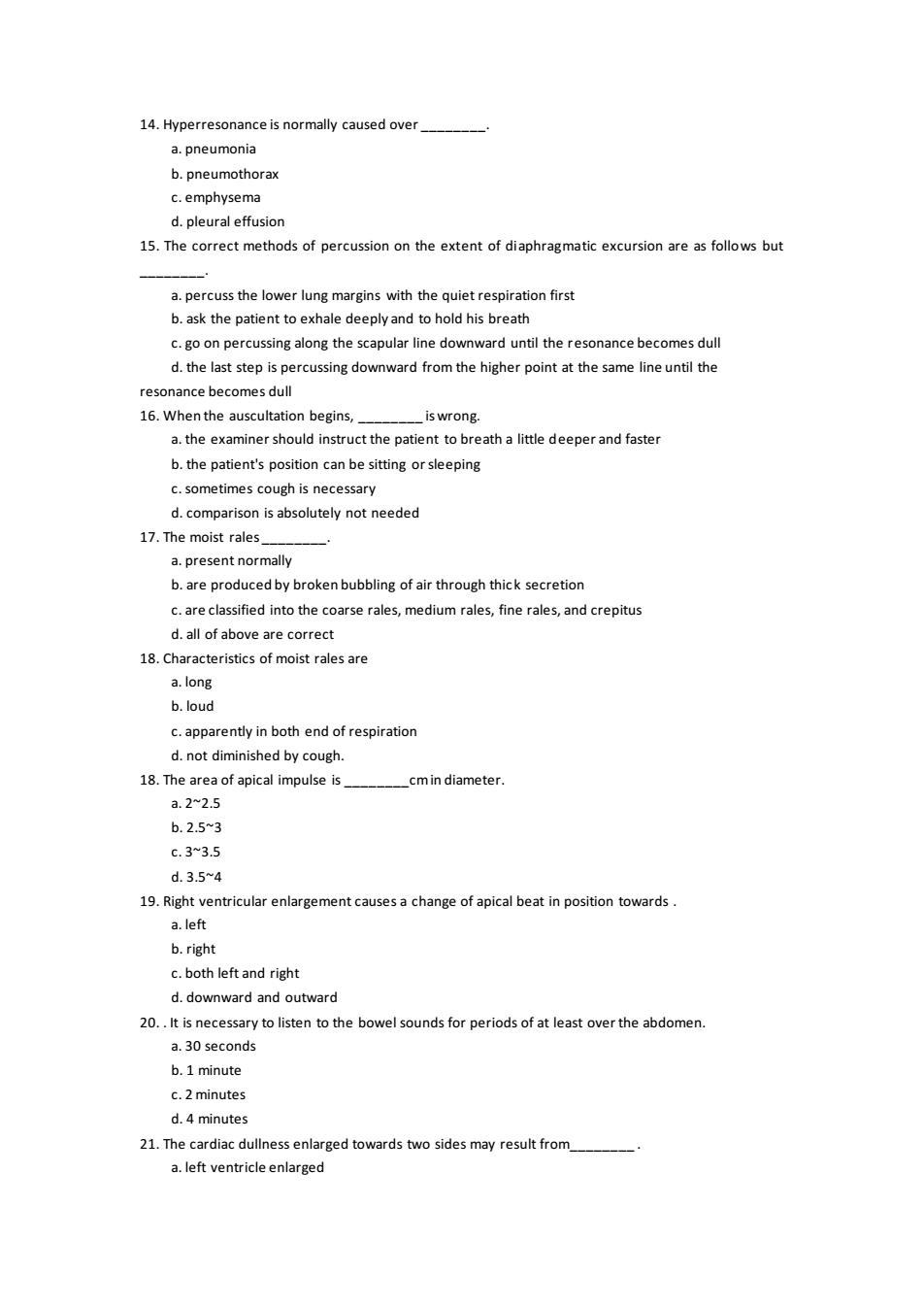
14.Hyperresonance is normally caused over_ a.pneumonia b.pneumothorax c.emphysema d.pleural effusion 15.The correct methods of percussion on the extent of diaphragmatic excursion are as follows but b.ask the patient to exhale deeply and to hold his breath c.go on percussing along the scapular line downward until the resonance becomes dull d.the last step is percussing downward from the higher point at the same line until the resonance becomes dull 16.When the auscultation begins b.the patient's position can be sitting or sleeping c.sometimes cough is necessary d.comparison is absolutely not needed 17.The moist rales ubroken bubbling ofaro c.are classified into the coarse rales,medium rales,fine rales,and crepitus d.all of above are correct 18.Characteristics of moist rales are a.long b.loud c.apparently in both end of respiration d.not diminished by cough. 18.The area of apical impulse is_ cmin diameter a.22.5 h25w3 c.335 d.3.54 19.Right ventricular enlargement causes a change of apical beat in position towards. a left c.both left and right d.downward and outward 20.It is necessary to listen to the bowel sounds for periods of at least over the abdomen. a.30 seconds b.1minute d.4 minutes 21.The cardiac dullness enlarged towards two sides may result from a.left ventricle enlarged
14. Hyperresonance is normally caused over _. a. pneumonia b. pneumothorax c. emphysema d. pleural effusion 15. The correct methods of percussion on the extent of diaphragmatic excursion are as follows but _. a. percuss the lower lung margins with the quiet respiration first b. ask the patient to exhale deeply and to hold his breath c. go on percussing along the scapular line downward until the resonance becomes dull d. the last step is percussing downward from the higher point at the same line until the resonance becomes dull 16. When the auscultation begins, _ is wrong. a. the examiner should instruct the patient to breath a little deeper and faster b. the patient's position can be sitting or sleeping c. sometimes cough is necessary d. comparison is absolutely not needed 17. The moist rales _. a. present normally b. are produced by broken bubbling of air through thick secretion c. are classified into the coarse rales, medium rales, fine rales, and crepitus d. all of above are correct 18. Characteristics of moist rales are a. long b. loud c. apparently in both end of respiration d. not diminished by cough. 18. The area of apical impulse is _cm in diameter. a. 2~2.5 b. 2.5~3 c. 3~3.5 d. 3.5~4 19. Right ventricular enlargement causes a change of apical beat in position towards . a. left b. right c. both left and right d. downward and outward 20. . It is necessary to listen to the bowel sounds for periods of at least over the abdomen. a. 30 seconds b. 1 minute c. 2 minutes d. 4 minutes 21. The cardiac dullness enlarged towards two sides may result from_ . a. left ventricle enlarged
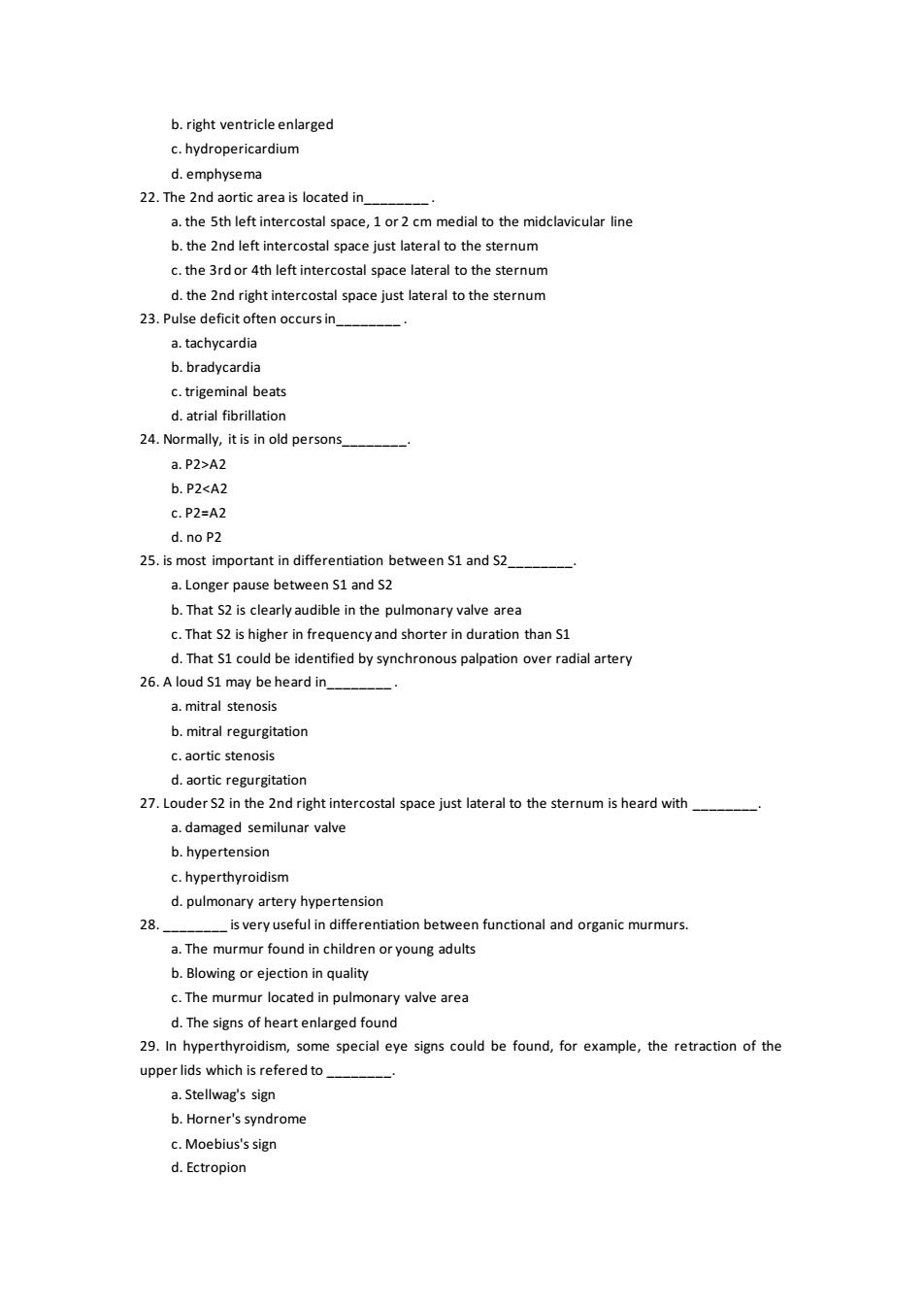
b.right ventricle enlarged c.hydropericardium d.emphysema 22.The 2nd aortic area is located in a.the 5th left intercostal space.1 or 2 cm medial to the midclavicular line b.the 2nd left intercostal space just lateral to the sternum c.the 3rdor 4th left intercostal space lateral to the sternum d.he2ndrnghtniercosalspacejustlaieraltothesernum 23.Pulse a.tachycardia b.bradycardia c.trigeminal beats d.lti it is in old persons a.P2>A2 b.P2<A2 c P7=A2 d.no P2 a.Longer pause between 51 and 52 b.That $2 is clearly audible in the pulmonary valve area c.That $2 is higher in frequency and shorter in duration than S1 d.That be identified by synchronous palpation over radial arter 26.A loud S1 may be heard in a.mitral stenosis b.mitral regurgitation c.aortic stenosis d.aortic regurgitation a.damaged semilunar valve b.hypertensior c.hyperthyroidism d.pulmonary artery hypertension 8 isveryuseful in differentiaion between functional and organic murmurs a.The murur found b.Blowing or ejection in quality c.The murmur located in pulmonary valve area d.The signs of heart enlarged found 29.In hyperthyroidism.some special eve signs could be found.for example.the retraction of the is referedto a.Stellwag's sign b.Horner's syndrome c.Moebius's sign d.Ectropion
b. right ventricle enlarged c. hydropericardium d. emphysema 22. The 2nd aortic area is located in_ . a. the 5th left intercostal space, 1 or 2 cm medial to the midclavicular line b. the 2nd left intercostal space just lateral to the sternum c. the 3rd or 4th left intercostal space lateral to the sternum d. the 2nd right intercostal space just lateral to the sternum 23. Pulse deficit often occurs in_ . a. tachycardia b. bradycardia c. trigeminal beats d. atrial fibrillation 24. Normally, it is in old persons_. a. P2>A2 b. P2<A2 c. P2=A2 d. no P2 25. is most important in differentiation between S1 and S2_. a. Longer pause between S1 and S2 b. That S2 is clearly audible in the pulmonary valve area c. That S2 is higher in frequency and shorter in duration than S1 d. That S1 could be identified by synchronous palpation over radial artery 26. A loud S1 may be heard in_ . a. mitral stenosis b. mitral regurgitation c. aortic stenosis d. aortic regurgitation 27. Louder S2 in the 2nd right intercostal space just lateral to the sternum is heard with _. a. damaged semilunar valve b. hypertension c. hyperthyroidism d. pulmonary artery hypertension 28. _ is very useful in differentiation between functional and organic murmurs. a. The murmur found in children or young adults b. Blowing or ejection in quality c. The murmur located in pulmonary valve area d. The signs of heart enlarged found 29. In hyperthyroidism, some special eye signs could be found, for example, the retraction of the upper lids which is refered to _. a. Stellwag's sign b. Horner's syndrome c. Moebius's sign d. Ectropion